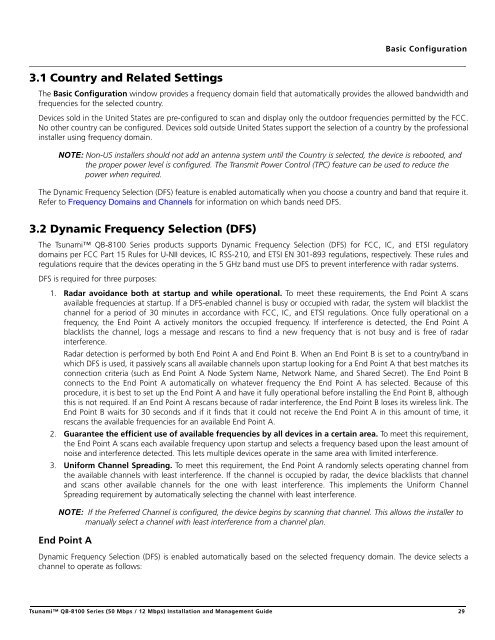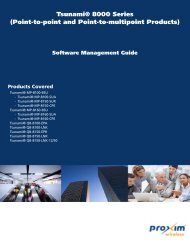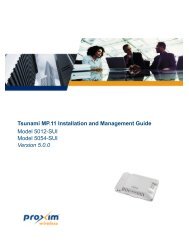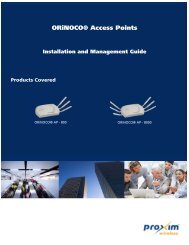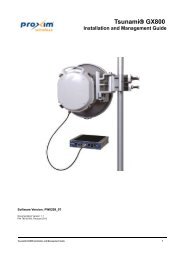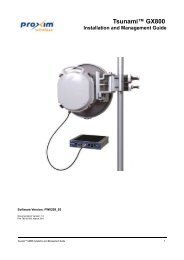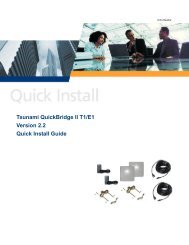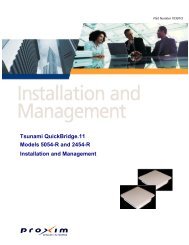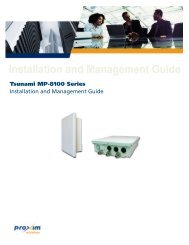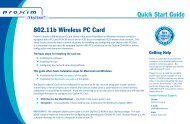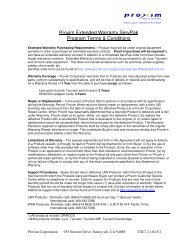Tsunami™ QB-8100 Series (50 Mbps / 12 Mbps)
Tsunami™ QB-8100 Series (50 Mbps / 12 Mbps)
Tsunami™ QB-8100 Series (50 Mbps / 12 Mbps)
Create successful ePaper yourself
Turn your PDF publications into a flip-book with our unique Google optimized e-Paper software.
Basic Configuration3.1 Country and Related SettingsThe Basic Configuration window provides a frequency domain field that automatically provides the allowed bandwidth andfrequencies for the selected country.Devices sold in the United States are pre-configured to scan and display only the outdoor frequencies permitted by the FCC.No other country can be configured. Devices sold outside United States support the selection of a country by the professionalinstaller using frequency domain.NOTE: Non-US installers should not add an antenna system until the Country is selected, the device is rebooted, andthe proper power level is configured. The Transmit Power Control (TPC) feature can be used to reduce thepower when required.The Dynamic Frequency Selection (DFS) feature is enabled automatically when you choose a country and band that require it.Refer to Frequency Domains and Channels for information on which bands need DFS.3.2 Dynamic Frequency Selection (DFS)The Tsunami <strong>QB</strong>-<strong>8100</strong> <strong>Series</strong> products supports Dynamic Frequency Selection (DFS) for FCC, IC, and ETSI regulatorydomains per FCC Part 15 Rules for U-NII devices, IC RSS-210, and ETSI EN 301-893 regulations, respectively. These rules andregulations require that the devices operating in the 5 GHz band must use DFS to prevent interference with radar systems.DFS is required for three purposes:1. Radar avoidance both at startup and while operational. To meet these requirements, the End Point A scansavailable frequencies at startup. If a DFS-enabled channel is busy or occupied with radar, the system will blacklist thechannel for a period of 30 minutes in accordance with FCC, IC, and ETSI regulations. Once fully operational on afrequency, the End Point A actively monitors the occupied frequency. If interference is detected, the End Point Ablacklists the channel, logs a message and rescans to find a new frequency that is not busy and is free of radarinterference.Radar detection is performed by both End Point A and End Point B. When an End Point B is set to a country/band inwhich DFS is used, it passively scans all available channels upon startup looking for a End Point A that best matches itsconnection criteria (such as End Point A Node System Name, Network Name, and Shared Secret). The End Point Bconnects to the End Point A automatically on whatever frequency the End Point A has selected. Because of thisprocedure, it is best to set up the End Point A and have it fully operational before installing the End Point B, althoughthis is not required. If an End Point A rescans because of radar interference, the End Point B loses its wireless link. TheEnd Point B waits for 30 seconds and if it finds that it could not receive the End Point A in this amount of time, itrescans the available frequencies for an available End Point A.2. Guarantee the efficient use of available frequencies by all devices in a certain area. To meet this requirement,the End Point A scans each available frequency upon startup and selects a frequency based upon the least amount ofnoise and interference detected. This lets multiple devices operate in the same area with limited interference.3. Uniform Channel Spreading. To meet this requirement, the End Point A randomly selects operating channel fromthe available channels with least interference. If the channel is occupied by radar, the device blacklists that channeland scans other available channels for the one with least interference. This implements the Uniform ChannelSpreading requirement by automatically selecting the channel with least interference.NOTE: If the Preferred Channel is configured, the device begins by scanning that channel. This allows the installer tomanually select a channel with least interference from a channel plan.End Point ADynamic Frequency Selection (DFS) is enabled automatically based on the selected frequency domain. The device selects achannel to operate as follows:Tsunami <strong>QB</strong>-<strong>8100</strong> <strong>Series</strong> (<strong>50</strong> <strong>Mbps</strong> / <strong>12</strong> <strong>Mbps</strong>) Installation and Management Guide 29


